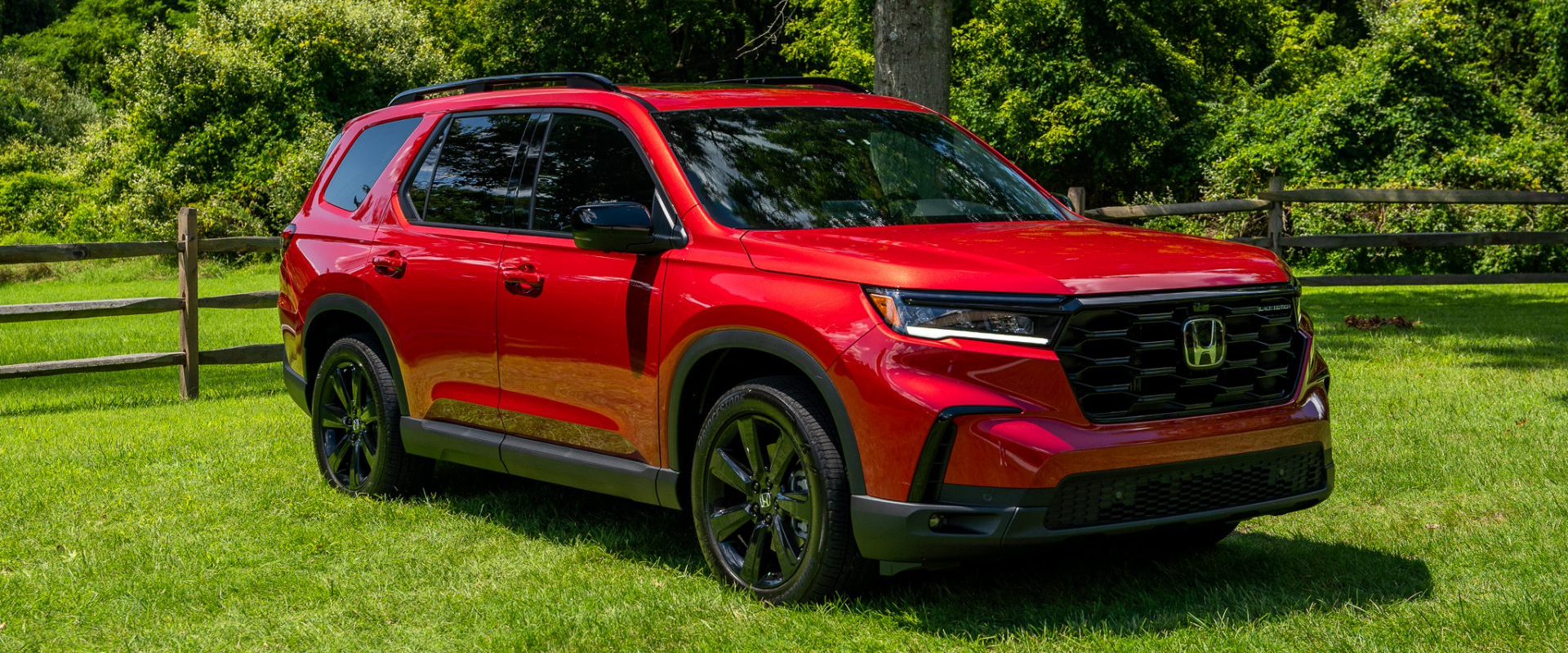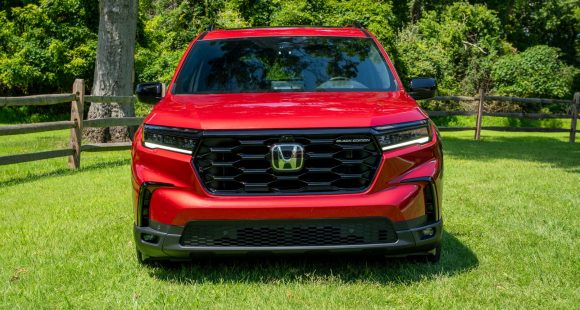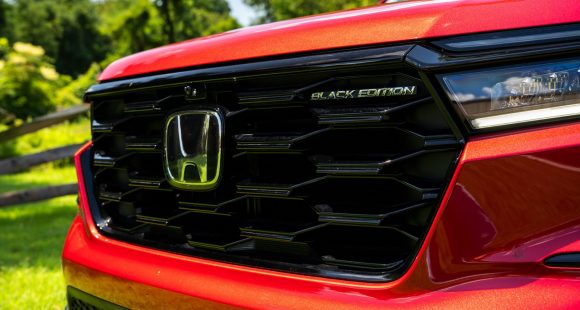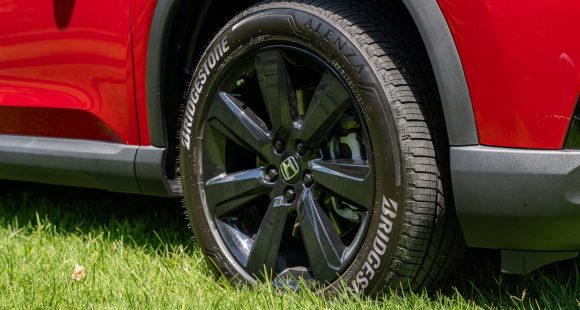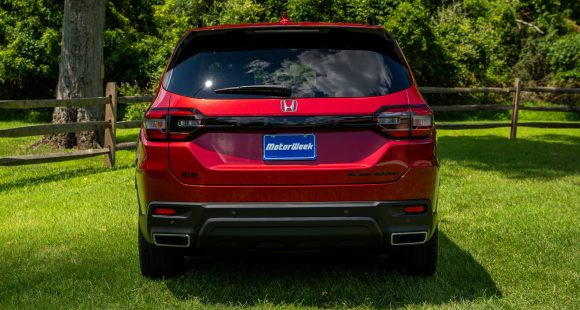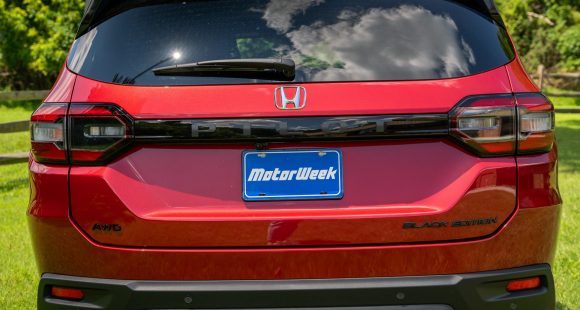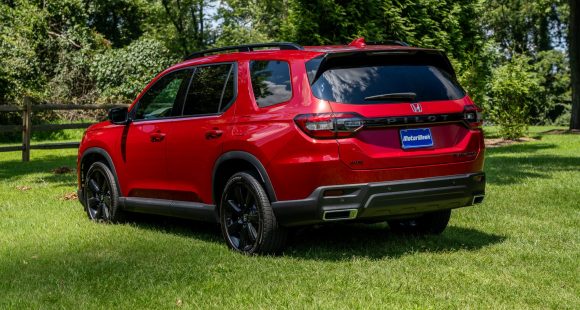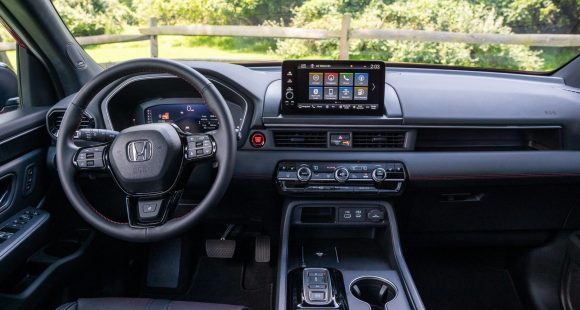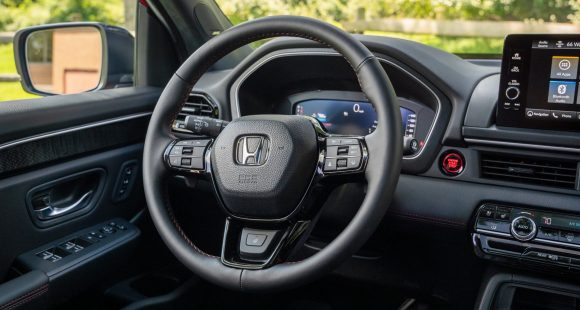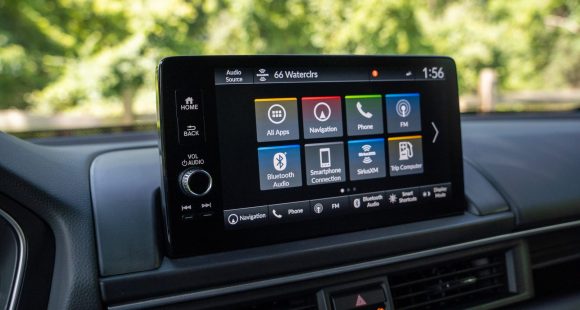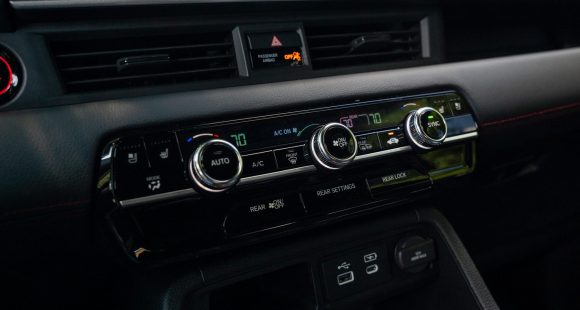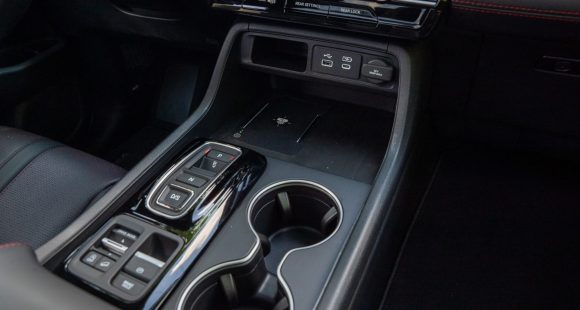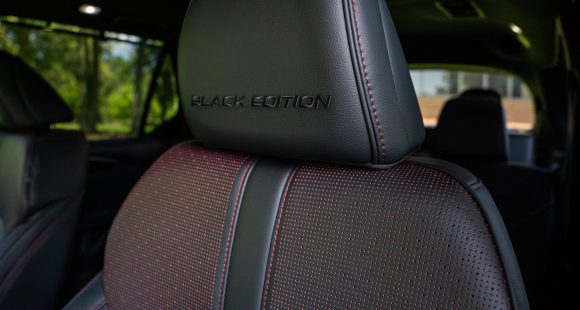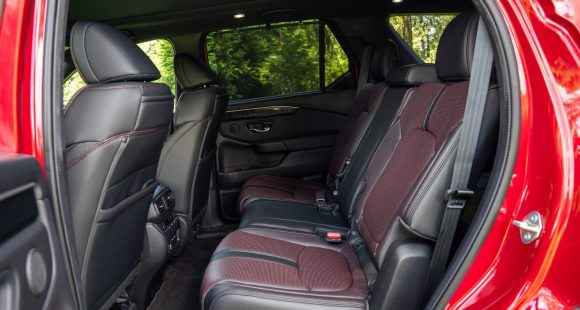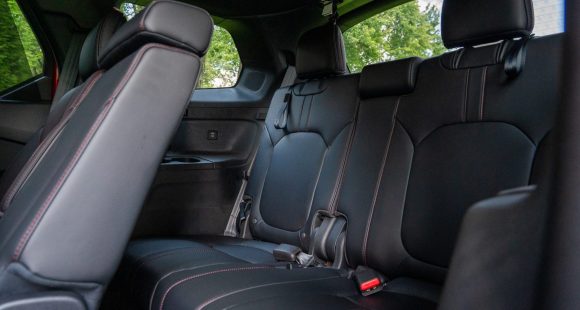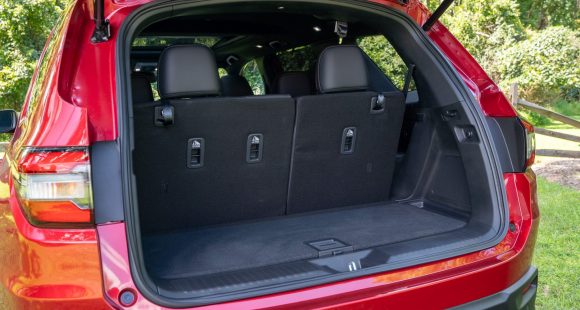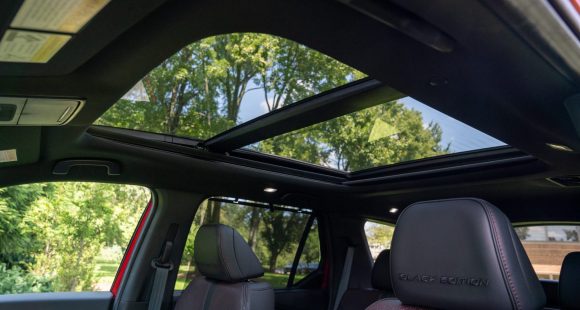2018 Kia Stinger
The Kia brand has come a long way in a short time, both in design and quality. But, as good as their vehicles are today, their long range goal seems directed at being a true Asian alternative to European luxury-sport brands. That’s a tall order, and for it, they have ordered up an all-new rear-wheel drive sedan, the Stinger. So, let’s see if rivals should be looking for bug spray.
Kia has been working towards building more exciting and dynamic cars for a few years now, but this 2018 Kia Stinger is their biggest step yet. While called a sedan, it’s really a well-camouflaged 5-door hatchback.
But, under its fastback skin lies the more important story, a finely-balanced, rear-drive chassis shared with the forthcoming Genesis G70, supported by struts in the front, and 5-links in the rear.
Under the long hood is a longitudinal, class requisite, base turbocharged 2.0-liter I4 with 255-horsepower and 260 lb-ft. of torque. But, our test Stinger GT packs a 3.3-liter twin-turbo V6 good for 365-horsepower and 376 lb-ft. of torque. Both hook up to 8-speed automatic with paddle shifters; there’s no manual, but both can add all-wheel-drive.
 While the 2.0 is no slouch, the GT’s V6 powertrain really impressed us with its overall smoothness. Even the paddle shifters work with a quick precision we didn’t expect.
While the 2.0 is no slouch, the GT’s V6 powertrain really impressed us with its overall smoothness. Even the paddle shifters work with a quick precision we didn’t expect.
Size wise, the Stinger is almost mid-size, being bigger than a 3-Series but smaller than a 5. Apart from its tiger nose, the Stinger doesn’t favor anything else in the Kia stable. It nails the luxuriously sporty look, attracting the kind of attention usually reserved for exotics.
We’ll admit there are some Audi cues; but hey, if you’re going to copy someone, you should make it one of the best. We also acknowledge the touch of cheapness with fender and non-functional hood trim, but they certainly didn’t go cheap down below, with Michelin Pilot Sports on 19–inch rims and Brembo brakes all around.
Quad exhaust tips look great and sound even better. Especially when streaking down the track with the 3.3-liter at full boil. It doesn’t snarl and bark like a HEMI Charger sedan, as its smooth and quick acceleration feels purely European.
All-wheel-drive grip and well-designed launch control make for simple, drama-free launches. There’s hardly any sense of weight transfer either. It’s one second you’re sitting still, and the next you’re at full power. We hit 60 in just 4½ of those serene seconds.
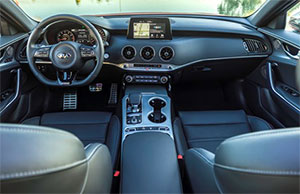 If you’re looking for hard-firing, throw you back in your seat, torquey shifts; you won’t find them here either. The gears are indeed changing, but the only sensation you get is just calm unrelenting thrust.
If you’re looking for hard-firing, throw you back in your seat, torquey shifts; you won’t find them here either. The gears are indeed changing, but the only sensation you get is just calm unrelenting thrust.
The car feels very stable at high speeds, as we reached 108 miles-per-hour in the ¼, completed in 13.1-seconds.
While there’s nothing exotic in the basic suspension theory, it’s all in the tuning, which as you may have heard by now, was overseen by Albert Biermann formerly of BMW’s M Division. And the results feel totally in that realm.
There was massive grip through our cones, staying nice and stable with minimum flex. Steering is impressively quick with decent feel. Plus, five comprehensive drive modes, including a custom setting, come standard. We can’t wait to get this GT on a proper race course.
Those Brembos brought this 4,000-lbs. hatchback to a halt in just 105-feet; minimal fade with an overall tight and sporty feel.
But of course we can’t all live our lives a quarter mile at a time, so it’s good to know the Stinger is just as pleasurable sitting in traffic. It never feels like a thoroughbred waiting to run free; rather more like a luxury car with tremendous performance potential.
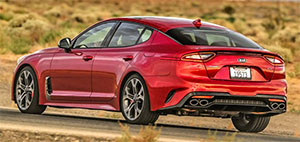 There’s plenty of room in the cabin, both front and rear. V6 GT trim comes with a nice flat-bottom steering wheel, rear view camera, and aluminum trim.
There’s plenty of room in the cabin, both front and rear. V6 GT trim comes with a nice flat-bottom steering wheel, rear view camera, and aluminum trim.
Stepping up to GT1 will get you navigation, a sunroof, and 720-watts of Harmon Kardon premium audio.
Finally, GT2 adds Nappa leather trim, a head-up display, and a host of advanced safety features.
And just for fun and quirkiness, the fact that Stinger’s key fob resembles some kind of detonator, just gives you a hint of what you’re about to set off when get behind the wheel.
There is a practical side as well; hatchback versatility means a wide opening with 23.3 cubic-ft. of cargo space, 40.9 with rear seat backs folded.
Government Fuel Economy Ratings for an all-wheel-drive GT are 19-City, 25-Highway, and 21-Combined.
Pricing starts at $39,250 for the GT; but pro tip, base models look virtually identical outside, are almost as fast, and start a few grand less than a 3 Series at $32,800.
While it was easy to be impressed with the first effort at building a true European-style sport sedan from Kia, we’d be just as impressed with the 2018 Stinger if had come from a more established marque; it’s that spectacular. But it’s what’s coming next that has us really excited, as a whole new adrenaline-packed era for Kia has begun.
Specifications
- Engine: 2.0 liter / 3.3 liter
- Horsepower: 255 / 365
- Torque: 260 lb-ft. / 376 lb-ft.
- 0-60 mph: 4.5 seconds
- 1/4 mile: 13.1 seconds @ 108 mph
- EPA: 19 mpg city / 25 mpg highway,
2024 Toyota Land Cruiser
Toyota’s Go Anywhere Globetrotter Returns To U.S.
Every once in a while, we all need a reset. A time to get back to basics and prioritize the things that really matter. Well, for the Toyota Land Cruiser that time is now. So, let’s find out if that means bigger and better things for Toyota’s iconic off-roader.
The Toyota Land Cruiser’s status among the global off-road community is legendary, and it’s hard to imagine there’s any corner of the earth where a Land Cruiser hasn’t kicked up a little dust or mud. Well, 2024 sees the return of the Land Cruiser to the U.S. market after a 3-year hiatus, getting a major reset for the journey.
The reset comes mostly by no longer being based on the large three-row “300-series” chassis, but a new version of the smaller “200-series,” now known as the J250. As with the latest Tacoma, it uses the Tundra pickup’s full-size steel frame.
While the main Land Cruiser model, which goes by simply Land Cruiser, is packed full of luxury and convenience features, there is also a stripped-down model known as the 1958, honoring the first year the Land Cruiser made landfall here in North America. And it is that 1958 we have here, and we were glad to see it, as it also celebrates the original’s back-to-basics approach as a blank canvas for you to personalize as you tackle more and more adventures.
Not that it’s fully stripped down, as 8-inch touchscreen infotainment, a 7-inch full-color multi-information display, and automatic climate control are still standard. Plus, some seriously durable materials, and great heated cloth front seats that throw off some get serious 1990s Tacoma vibes.
But outside, there’s a definite lack of flashy trim and basic looking 18-inch wheels with Yokohama Geolander all-season tires; plus, big chunky bumpers and tilt-up back glass, which is a rarity that we appreciate. Though there is a little too much plastic in places that are sure to see some abuse if you do any significant off-roading.
It even feels a little rough around the edges, but for us it just adds to the rugged old-school utility vibe in a good way.
We did just that, both here in the Mid-Atlantic as well as in the California desert; and while there are some tech-forward driving aids, the actual hardware is in most cases plenty to get things done. That includes standard full-time dual-range four-wheel-drive, locking center and rear diffs, and 8.7-inches of ground clearance. A front stabilizer bar disconnect is also available to allow for increased articulation.
Who needs a V6 or even a V8 when you’ve got Toyota’s i-FORCE MAX setup at your disposal with 326 horsepower and 465 lb-ft of torque coming from a 2.4-liter turbo-four with an electric motor sandwiched between the engine and its eight-speed automatic transmission. Low speed torque delivery is impressive. It even feels a little rough around the edges, which may be a turn off to some, but for us it just adds to the rugged old-school utility vibe in a good way.
And it certainly feels quicker than an off roader needs to be, with an instant torque dump as soon as we eased on the throttle at our Mason Dixon test track; helping us get to 60 in 8.1 seconds and through the quarter-mile in 16.3 seconds at 86 mph. Considering the Land Cruiser’s terrain conquering mission, it behaved quite well in our handling course; it was plenty responsive to inputs, with less body roll than we expected and plenty of grip from the tires. The steering was light and quick but as expected didn’t provide much feel. Other than significant nosedive, braking performance was exceptional. Only 107-feet to panic stop us from 60 mph.
With the shift to the smaller size, there’s no more third row available, and cargo capacity now comes in at 46.2 cubic-feet with a max of a still healthy 82.1. Now, the best part of the Land Cruiser’s return is the entry price of $57,445. That’s about 30-grand less than what the last Land Cruiser went for back in 2021.
Whether it’s over the top fashion trends, mullets, or zombies; just when you think they’re dead, they come roaring back to life. Of course, we’re much happier to see the resurrection of this 2024 Toyota Land Cruiser than any of those things. Toyota is one brand that still recognizes the value of full-framed rugged rigs and has also acknowledged that sometimes less really is more. The Godfather of Toyota off-roading is back and better than ever.
2025 Honda Pilot Black Edition
Honda’s Most Elite Pilot Gets More Elite
Honda began their Pilot crossover program back in 2003, and it didn’t take long to see that this three-row ute was ready for prime time. Now in its 4th-generation, Honda has created the most off-road capable Pilot yet, but this year, they focus on another set of enthusiasts. Time for us to shine a line on this new Black Edition.
Honda has certainly been an elite performer in the SUV world since their CR-V first hit the pavement in the late 1990s. So much so, they’ve been using the term “elite” to mark their top trim level for years now.
Well, things rarely stay the same for too long in the car marketing world. Combine that with buyers willing to pay more and more for added bling, and there’s a new king of the Honda hill; Black Edition. Seen here on this 2025 Honda Pilot Black Edition.
Now the 4th generation Pilot was all-new for 2023, and after our test of the new off-road inspired TrailSport version, we were eager to get a taste of the finer things of Honda life. Now the Black Edition doesn’t so much add features, as ratchet up the Pilot’s style game with 20-inch gloss-black wheels and unique trim inside and out.
For the exterior, that also means glossy dark treatments applied to the grille, side mirrors, window trim, air intakes in the front fascia, and rear bumper; plus, unique logos of course.
Inside, exclusive red accent stitching is applied to the seats, steering wheel, and door panels; plus, red accent lighting and Black Edition logos.
Like every Pilot, 3-row seating is standard. But, while both 1st and 2nd rows are very spacious, that 3rd row is best suited for kids, and the 1-touch access is about as easy as it gets.
Storage space is great too, and with multiple folding options for the 2nd row, it offers a lot of flexibility and a nice flat floor when everything’s folded. There’s 18.6 cubic-ft. of room behind the 3rd row, 48.5 behind the 2nd, and a giant 86.5 with all seatbacks folded.
Front seating is as comfortable as it is spacious, and while the Pilot’s 9-inch touchscreen is relatively small by the latest standards, it, as well as the rest of the controls, are simple and straightforward to operate.
Storage space is great too, and with multiple folding options for the 2nd row, it offers a lot of flexibility.
Producing the Pilot’s get-up-and-go is Honda’s familiar naturally aspirated 3.5-liter V6, outputting 285-horsepower and 262 lb-ft. of torque. It flows through a 10-speed automatic transmission to the front wheels. All-wheel-drive with Intelligent Variable Torque Management is available in Sport, EX-L, and Touring trims. It’s standard for TrailSport, Elite, and of course, Black Edition.
Power felt more than adequate on the street. But what about at our Mason Dixon test track?
Here too power felt strong off the line. But, our computer showed it tempered quickly, taking a longish 8.2-seconds to reach 60. That’s also quite a bit off the pace of the 6.8-seconds we saw in the TrailSport two years ago. Gear changes in the 10-speed automatic were very smooth, but also a little slow, as we worked our way to the end of the ¼-mile in 15.9-seconds at 90 miles-per-hour.
Minimal body roll and a moderate amount of understeer set the tone in our handling course, where this Pilot felt well planted and easy to control, with very little stability system intervention, even as we carried fairly high speeds through the cones.
Panic stops from 60 averaged a good 115-feet. There was a fair amount of nosedive, but results were quite consistent thanks to minimal fade.
So, despite a somewhat slow roll out, we were pleased with the Pilot’s overall very competent and safe track performance.
Back to the street, Government Fuel Economy Ratings, with all-wheel-drive are 19-City, 25-Highway, and 21-Combined; we averaged a good 24.2 miles-per-gallon of Regular.
The Energy Impact Score is slightly below average, using 14.2-barrels of oil annually, with CO2 emissions of 7.0-tons.
With a new top end trim level, Honda also eliminated one at the bottom; no more LX. Sport is now the base model starting at $41,595, with all-wheel-drive a $2,100 option. Top Black Edition starts at $55,975.
The Honda Pilot has been a leader in the 3-row SUV segment ever since it arrived on the scene for 2003, delivering capability, reliability, and driving dynamics well above its class norm. So, after focusing on off-road ruggedness in recent years, the 2025 Honda Pilot Black Edition adds a welcomed bit of black-tie flair to the Honda SUV party.
Specifications
As Tested
- Engine: 3.5-liter V6
- Transmission: 10-speed automatic
- Horsepower: 285
- Torque: 262 lb-ft.
- EPA: 19 City | 25 Highway | 21 Combined
- 0-60 mph: 8.2 seconds
- 1/4 Mile: 15.9 seconds at 90 mph
- Braking, 60-0 (avg): 115 feet
- MW Fuel Economy: 24.2 MPG (Regular)








